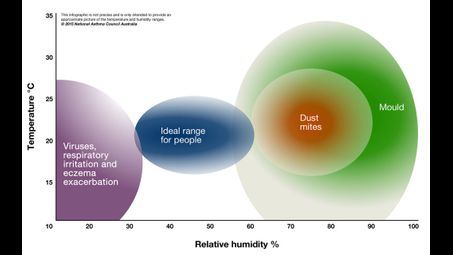A research by ASHRAE (American Society of Heating, Refrigeration and Air Conditioning Engineers) shows that the ideal indoor humidity level for health is about 40%-60%.
Dry environment with humidity level below 40% will not only result in dry skin and hair, but also make viruses and bacteria more active, therefore increase the likelihood of being infected by colds and other respiratory illnesses. Studies have shown that the survival rate of influenza virus can be as high as 70% in an environment of about 20% humidity level. The effectiveness of mucosal clearance and the body's resistance function to airborne viruses, will be greatly reduced when the relative humidity is less than 40%.
You can use a hygrometer to measure the indoor humidity. You can use a humidifier to adjust the humidity of your room. There are different sizes of humidifiers and they each have a different humidifier rating, as well as square footage usually covered. Cool mist/evaporative humidifiers are generally cheaper than warm mist and ultrasonic ones. Good brands such as Dyson, Keecoon【large-scale capacity】, Panasonic, etc.

Add your answer:
What should the low and high end for humidity temperatures for your home?
The recommended humidity range for indoor spaces is typically between 30-50%. Lower humidity levels can lead to respiratory issues and dry skin, while higher levels can promote mold growth and dust mites. It's important to maintain a balance to ensure comfort and prevent potential health issues.
Is an air exchanger effective in controlling humidity?
Yes, an air exchanger can help control humidity by exchanging indoor and outdoor air, which can help remove excess moisture. It can also help improve indoor air quality by bringing in fresh air and removing pollutants. However, the effectiveness of an air exchanger in controlling humidity will depend on factors such as the size of the unit and the specific conditions in the indoor environment.
Can you put an outdoor ceiling fan inside?
It is not recommended to install an outdoor ceiling fan inside as outdoor fans are designed to withstand elements like moisture and humidity that indoor fans do not need to contend with. Using an outdoor fan indoors may not be as safe or efficient as using a fan specifically designed for indoor use.
Your room temperature is 80 degrees What is the right number should you set on your humidity machine?
It's recommended to set the humidity level between 30-50% when the room temperature is 80 degrees Fahrenheit to maintain a comfortable and healthy indoor environment while preventing issues like mold growth. Start by setting the humidity machine to around 45% and adjust as needed based on your comfort and the humidity levels in the room.
Does an ionizer take away from humidity?
An ionizer does not directly affect humidity levels in the air. However, in some cases, ionizers may produce ozone which can react with humidity to form other compounds that might affect indoor air quality.
What is good humidity for indoor pool?
The usual design humidity for an indoor swimming pool is 50% RH when unoccupied and 60% RH when occupied Peter Fenton. Consulatant. Indoor-Pool-Design.com
Do plants increase indoor humidity?
Yes
What is the ideal indoor temperature and humidity?
75 degrees F OK that's fine for temperature but what is the ideal room humidity percentage? Actually, most building codes only require you at keep the temperature at 68 degrees, which is ideal. The ideal room humidity percentage is usually around 50% ASHRAE Standards: 68-74F @40-60% relative humidity in the Winter 73-79F @40-60% relative humidity in the Summer
What is the ideal Indoor humidity?
A research by ASHRAE (American Society of Heating, Refrigeration and Air Conditioning Engineers) shows that the ideal indoor humidity level for health is about 40%-60%.You can use a hygrometer to measure the indoor humidity. You can use a humidifier to adjust the humidity of your room. There are different sizes of humidifiers and they each have a different humidifier rating, as well as square footage usually covered. Cool mist/evaporative humidifiers are generally cheaper than warm mist and ultrasonic ones. Good brands such as Dyson, Keecoon【large-scale capacity】, Panasonic, etc.
What is the recommended humidity in a home?
30-40%
What should the low and high end for humidity temperatures for your home?
The recommended humidity range for indoor spaces is typically between 30-50%. Lower humidity levels can lead to respiratory issues and dry skin, while higher levels can promote mold growth and dust mites. It's important to maintain a balance to ensure comfort and prevent potential health issues.
Is an air exchanger effective in controlling humidity?
Yes, an air exchanger can help control humidity by exchanging indoor and outdoor air, which can help remove excess moisture. It can also help improve indoor air quality by bringing in fresh air and removing pollutants. However, the effectiveness of an air exchanger in controlling humidity will depend on factors such as the size of the unit and the specific conditions in the indoor environment.
What are the relative humidity limits recommended for residence?
50%
What is recommended psi for indoor plumbing?
50-75 psi
Do Venus Flytraps grow in UAE?
You can always grow them indoor with suitable humidity and distilled water.
What is a good way to increase indoor humidity in winter?
If you have de-humidifiers then just take out the plug.
What will increase the relative humidity in a home during winter?
Increasing indoor activities that produce moisture (like cooking or showering without ventilation), using a humidifier, or having indoor houseplants can all increase the relative humidity in a home during winter.
